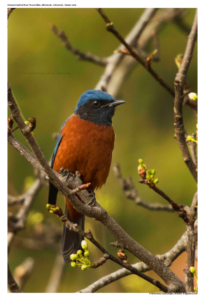Chestnut-bellied Rockthrush

Chestnut-bellied Rock Thrush Monticola rufiventris
Etymology :
- Monticola : Latin word montis- mountain; cola – inhabitant
- Rufiventris : Latin word rufus – rufous ; ventris
Vernacular Names :Lepcha: Ningri-pho, Cachar: Daohangar
Distribution in India: Resident of Himalayas and North East India.
Description: Size of 21-23 cm. The male has grey-blue crown and upperparts, with blackish lores and ear-coverts continuing onto shoulders and merging with deep bluish-black throat, sharply divided from deep chestnut underside. In non-breeding plumage, the mantle and scapulars show whitish scaling with whitish wingbar. The female is dull grey-brown above, scalloped slate-grey and buffy-white below, with whitish-buff eyering, mesial stripe and prominent post-auricular patch. It breeds in open moist coniferous forest and oak, tanbark and rhododendron forest amid steep cliffs, boulders and streambeds, forest edges with clumps of bushes, banks and cliffs.
Habitat: It is found from 1800 to 3400 m in Himalayas. It winters on steep rocky hillsides with open fir-pine-cedar stands, often in heavily degraded open areas and pastures, evergreen forest edge, scrub country and rocky outcrops.
Food habits : It eats insects, such as craneflies, and including large ones such as cicadas, molluscs, small lizards, and sometimes berries. The larger preys are battered on branch before swallowing. It forages mainly on ground, but often perches high in bare trees, and makes occasional aerial sallies.
Breeding habits:
They breed in Mar–Jul in Himalayas, Apr in Myanmar and Apr–May in SE China. The nest is a cup of moss, leaves, grass and twigs, lined with roots and fine grass, placed deep in rock crevice or hollow in bank or amid tree roots, in inaccessible terrain. They lay a clutch of 3–6 eggs.